- Blog
- 10+ Ecommerce Email Templates & 20 Examples to Drive More Sales
10+ Ecommerce Email Templates & 20 Examples to Drive More Sales
-
Nikolett Lorincz
- Marketing
- 6 min read
Table of Contents
E-commerce email marketing is your golden ticket to growing your business. Every ecommerce email you send (from welcome emails to confirmation emails) is an opportunity to make a connection with your customers.
In this article, we’ll show you 20 great email marketing examples (covering all sorts of email types) and give you tips on how to build a healthy newsletter list. Plus, you’ll get 10+ free email templates that you can download and start using for your ecommerce business.
Let’s dive in!
20 ecommerce email examples to get inspired
We’ve collected some of the best ecommerce email examples to inspire you. Let’s break them down by type!
Welcome emails
People expect to get a welcome email when they subscribe to your email list, so you never want to skip this step.
Welcome emails help build the relationship between you and your email subscribers/new customers. You can use them to set expectations and give your subscribers the lowdown on what they’ll get from your emails, like promotions, new arrivals, or fashion tips.
Don’t forget to tell them how often they can expect to get your email campaigns, e.g. “Look out for our newsletter every Thursday.”
Let’s take a look at some awesome real-life examples.
1. Ann Taylor’s welcome email example with a discount
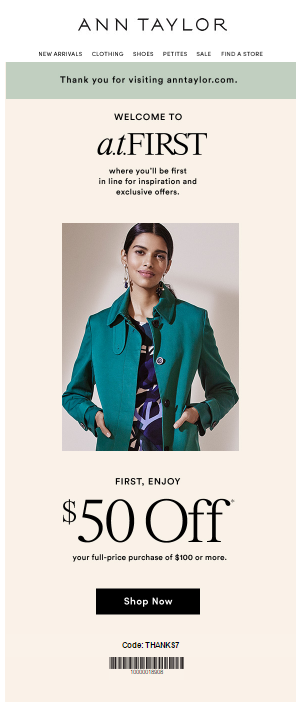
We love Ann Taylor’s email design because it’s simple, elegant, and highlights the offer. No one’s going to miss the $50 off promotion.
2. Boden’s warm welcome email example

Boden opens their welcome email with a short introduction that makes the reader feel special: “Welcome to our world. Shop our legendary sales before anyone else.” This warm approach helps lay the foundation for a strong connection with their new subscribers.
And Boden also knows that a discount offer is an essential part of welcome emails: theirs is for 15% off.
Replicate their approach by including warm, inviting language and personalization in your emails.
3. Bonobos’ straight-to-the-point email design

Bonobos’ welcome email is super simple and direct. They don’t take up any space with an elaborate introduction or photos. Instead, they focus on the promotion and a clear call-to-action.
This makes their email great for busy subscribers, who will be able to quickly scan through.
Their offer is for 20% off and free shipping on a customer’s first order. This is smart, because additional shipping costs are the number one reason buyers ditch their carts. Promising free shipping before subscribers shop is an awesome way to build goodwill and entice people to make a purchase.
4. Navabi’s multi-step automated emails
Navabi’s welcome email marketing strategy below hits all the right notes:
- Email one says thanks to new subscribers with a personal welcome and discount code for signing up.

- Email two motivates subscribers to use their time-sensitive discount code, driving purchases and inspiring brand loyalty.

- Email three puts the spotlight on the brand. It showcases their approach and values, helping them build brand awareness.

Want to ace your own welcome sequence like Navabi? Be sure to strike the right balance between providing value for your subscribers (i.e. with a unique discount code) and talking up your brand.
5. Fab’s welcome email with urgency
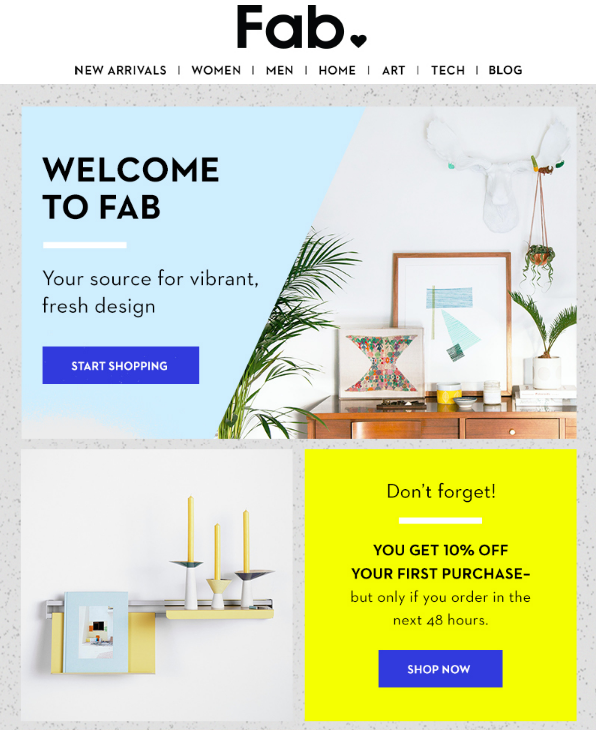
This email from Fab is another beautiful example to stash away in your swipe file.
This design-heavy email opts for a dynamic, super-engaging aesthetic with bold hues, fun fonts, and vibrant photos. The zig-zag, one-two-column design also catches the eye, making the email easy to read.
They also score points for keeping the text to a minimum. They just highlight their tagline and the subscriber’s time-sensitive offer.
In addition, they tap into the persuasive power of urgency by adding a deadline.
6. Aritzia’s introductory welcome email example

An image-centric email is perfect if you want to show off your products. Aritzia does this by highlighting their beautiful clothes and the benefits of shopping with them.
They introduce their brand by calling attention to the perks they offer, from luxe fabrics to awesome customer service. As such, this email captures readers’ attention by answering the question, “What’s in it for me when I shop this ecommerce store?”
Another awesome feature of this welcome email is that they invite people to connect with them on social media. Techjury reports that the average person has 200 emails in their inbox. In contrast, each person spends a whopping 145 minutes on social media each day. Make sure you stay top of mind by asking your subscribers to connect in your welcome emails.
Promotional emails
While welcome emails introduce subscribers to your company and inspire their very first purchases, the goal of promotional emails is to drive sales for your business.
Read on for promotional ecommerce email examples.
7. Shein’s thank you email with a discount for repeat purchases

Shein uses this thank you email to offer 40% off for existing customers to use on their next purchase.
This approach is a great way to inspire repeat purchases and build customer loyalty.
Keep in mind that it’s worth waiting a couple of weeks between the purchase and your promo email. Most customers won’t be ready to make another purchase immediately.
8. DODOcase’s seasonal email example
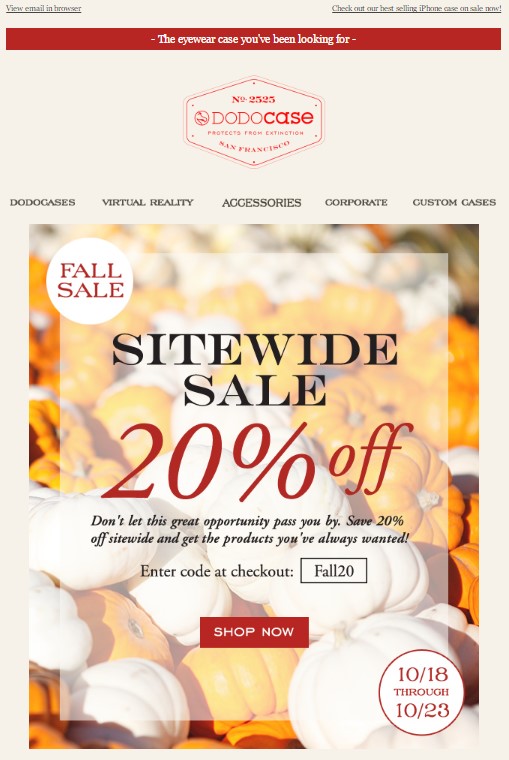
Here’s another great example of an eye-catching special offer. DODOcase encourages visitors to return to their ecommerce site and make a purchase with a special seasonal discount.
Seasonal offers are tied to specific periods of the year. They work super well because they build excitement around a certain season or event. These offers also help drive customer purchases because they’re time sensitive.
To really nail seasonal offers, go beyond Christmas, Black Friday, Easter, and other “standard” holiday promos. People quickly get bored when they see the same old holiday promos filling up their inboxes. Promote your own seasonal offers based on more unique or niche holidays like Galantines Day (celebrating female friendship on the 13th of February).
9. Rifle Paper Co.’s product recommendation email example

This email marketing example from Rifle Paper Co. is simply beautiful.
The colors and images are gorgeous, perfectly highlighting the product. This design-focused email is a great approach if you’re selling apparel or other items with aesthetic appeal.
Our favorite part of the email? Instead of giving a deadline, they confidently say “These bags won’t last long.” This highlights that the bags are desirable and coveted, encouraging immediate purchase.
10. J. Crew’s style inspiration email example

J. Crew’s email marketing strategy goes beyond a direct promotion. It helps customers solve a problem and provides a major dose of style inspiration.
They show three different ways to put together an outfit with their leopard print skirt. With this approach, J.Crew saves customers time and makes it more convenient to purchase a matching outfit.
They also provide added value by reminding shoppers that their 40% off sale ends today.
Imitate this email by diving deep into some of your audience’s common desires or issues.
11. Loft’s future sales announcement email example

Subscribers are used to getting promotional emails that announce sales. This means these kinds of emails can get buried in their inbox easily, especially during sales season (like Black Friday).
We love this ecommerce email marketing example from Loft because it highlights their upcoming sale in a fun, memorable way: they use a fun design and snappy, unforgettable copy.
To make your sale announcement email stand out, use fun sales copy and an interesting CTA button. “See what’s new” sparks curiosity and interest, as opposed to something overused and basic like “Click here” or “Shop now.”
Cart abandonment emails
Cart abandonment emails are sent to people who add items to their cart and leave your online store without buying.
The latest average global cart abandonment rate is 66.5%. That means that almost 7 out of 10 visitors who add an item to their shopping cart will abandon an online store before completing their purchase. With numbers like those, it’s not hard to see why including cart abandonment emails in your ecommerce email marketing strategy is a must.
Klaviyo reports that abandoned cart emails help businesses recover between 3% and 14% of lost sales.
These emails typically offer a reminder and incentive, such as a discount, coupon, or free shipping.
12. Google Express’ simple cart reminder email

Google Express keeps things simple. They focus subscribers’ attention on what they need to do next.
They include a visual reminder that showcases the items in the abandoned shopping cart and a direct CTA, “Check out now.”
13. Casper’s cart abandonment email with social proof
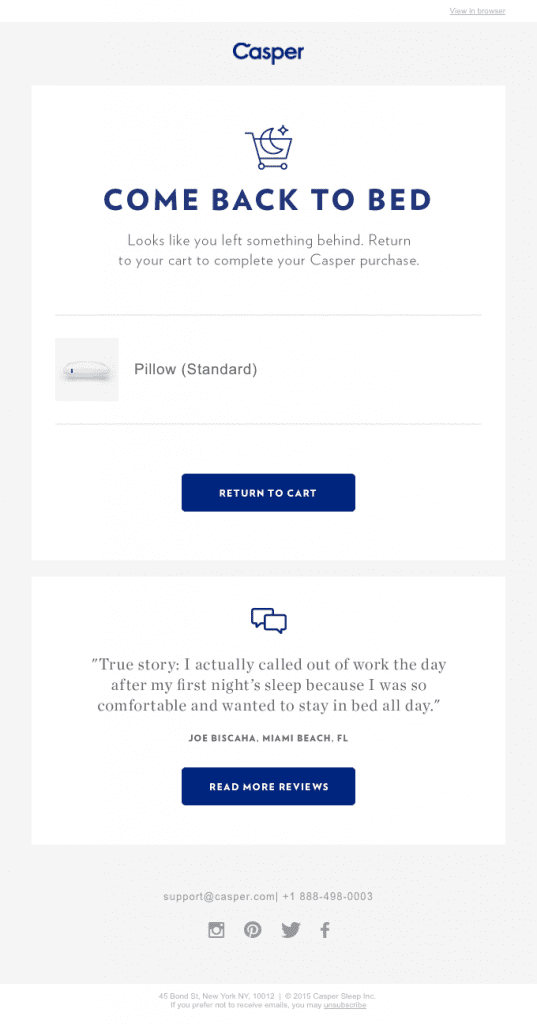
Casper levels up the persuasiveness of their cart abandonment email with a cheeky, memorable testimonial.
They use social proof in the form of positive applause from other customers, which is a great way to persuade your cart-ditching customers to carry through with their purchase.
Include a stellar review in your abandoned cart emails to make sure your customers have no doubts about their purchase.
14. Kate Spade’s cart recovery email with a discount

Kate Spade uses a 15% discount in their cart recovery email to convince visitors to complete their purchase. A discount gives cart abandoners the little jolt they need to finish checking out.
They also provide personalized recommendations based on the items in their customer’s cart.
What’s the takeaway here? Personalized discounts and recommendations are strategic ways to encourage customers to complete the checkout process.
15. J. Crew’s cart recovery email example

What makes this cart abandonment email from J.Crew special? That little red note: “NOW ON SALE.” This approach is a more subtle, powerful way of encouraging a return visit compared to a direct discount or coupon.
Test this line of text in your own ecommerce marketing emails.
Transactional emails
You’ve driven sales with your promotional emails, now it’s time to think about your post-purchase emails.
Post-purchase or transactional emails are messages that you send to your customers after they complete a purchase. These emails usually confirm that an order has been placed or that their items have been shipped.
These emails have extremely high open rates compared to promotional emails, because most customers expect to receive a confirmation of their order or shipment.
Let’s take a look at some examples of order confirmation emails to see what you can do with them!
16. Blue Bottle’s order confirmation email example

Blue Bottle’s email is great because they provide customers with all the information they need.
They include every detail of the purchase in the email. In addition, they give subscribers an easy way to contact them with any questions.
Be like Blue Bottle and provide extensive details on your customer’s orders in confirmation emails so they don’t have to log into their account to hunt for information.
17. Stradivarius’ order tracking email example

This email from Stradivarius is an ace example because they provide a link for customers to track their orders. Order tracking helps reduce customer anxiety and builds confidence in you as a reliable, transparent online store.
Build trust with your customers and explain what will happen next so they know exactly what to expect.
18. Huckberry’s confirmation email promoting referrals

Huckberry’s email confirms the order and entices customers to share Huckberry as a way to earn store credit. This is a good way to boost your company’s reach and attract new customers, all without lifting a finger.
At the end of the email, they also show trending products. This is another great ecommerce strategy to note.
When you don’t have a lot of data for customer personalization, recommending bestsellers and/or hot products is a smart way to get repeat customers.
Now let’s see a few great shipping confirmation emails!
19. Fitbit’s shipping confirmation email example

We like Fitbit’s email because of the friendly, playful tone they use. When it comes to ecommerce emails, it’s often smart to go for fun language instead of a message that’s easily forgettable.
Their email also has a clean look. The design and content are minimal, which means they don’t distract the reader unnecessarily. Keep your copy scannable to avoid annoying or confusing your readers.
20. Tradesy’s “order shipped” email example
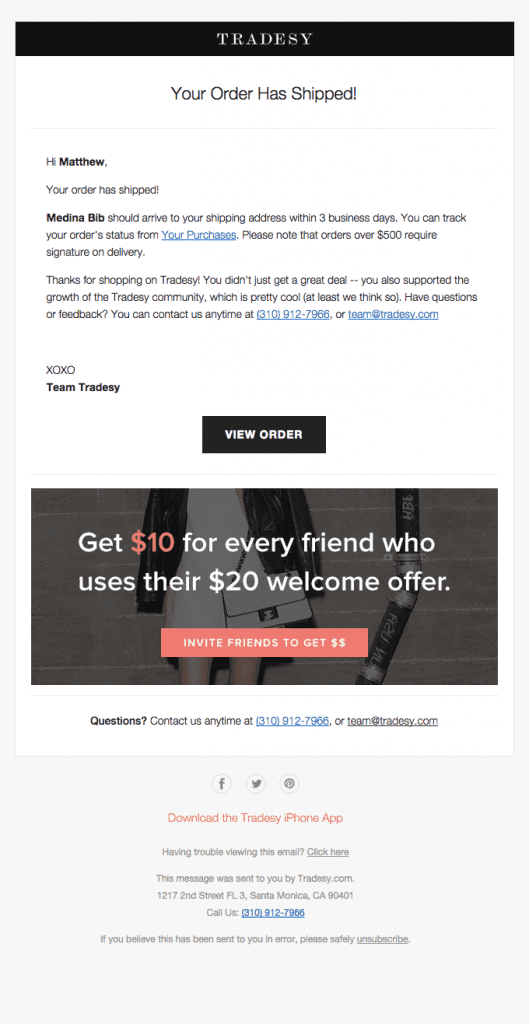
Tradesy’s shipping confirmation email gives customers a chance to invite their friends in exchange for a discount on their next purchase.
Recommendations from friends and family are highly persuasive. ReferralCandy found that 92% of consumers trust recommendations from people in their social circle.
Try this approach to gain both repeat customers and new customers.
10+ free email marketing templates
Now that you’ve seen some great ecommerce marketing emails, you’re probably excited to start improving your own email campaigns!
To get you started, check out our 10+ ecommerce email templates including welcome email templates, promotional email marketing templates, cart abandonment templates and transactional templates.
Download the email template swipe file now and start using them today for free!
Why and how to build an email marketing list?
Most businesses still see email marketing as the best channel to build relationships with customers and leads. In fact, 4 out of 5 marketers say they’d rather give up social media than email marketing.
People regularly use their smartphones to check emails. This means that emails are a great way to reach your customers during their busy day.
Here’s why you should focus on building your email list, according to CampaignMonitor:
- A message is 5x more likely to be seen in an email than via Facebook.
- Email is 40x more effective at acquiring new customers than Facebook or Twitter.
- Every $1 spent on email marketing generates a $38 ROI.
- Email marketing drives higher conversions than any other marketing channel, including search engines and social media.
Luckily, there are many simple ways to build a healthy email list.
And by “healthy email list,” we mean a list full of people who are actually interested in your products. Maintaining a healthy email list is referred to as email hygiene, and it involves:
- Regularly cleaning up your list of inactive subscribers. Remember, they’ll drag down the overall performance of your email marketing campaigns (e.g. by lowering your open rates and click-through rates).
- Segmenting your list (dividing your subscribers based on factors such as location, job, interests, etc.).
- Only sending your subscribers high-value, relevant content.
So what’s the best way to start building your list? Check out some of the proven strategies below.
1. Put a subscription box in your footer
Add a newsletter subscription box to the footer of your website. If a visitor wants to subscribe, that’s usually the first place they’ll look.
Check out this example from Best Buy:

2. Use subtle sidemessages
You can also promote your newsletter using a sidemessage. A sidemessage appears on the right or left side of your page and follows your visitor as they scroll down the page, making it hard to miss.
A sidemessage means that you won’t disturb visitors while they’re scrolling or viewing a product on your site.
You can use OptiMonk’s sidemessages to segment visitors and target them more effectively based on their location or interests.
3. Promote coupons on popups
Coupons and discounts are another awesome way to convince visitors to subscribe to your email marketing list.
Provide immediate value in exchange for their contact details by displaying a discount on a popup to drive new signups.
Here’s a sleek example from Mydeal.com.au. They provide a $10 coupon in exchange for signing up for their email list:

Get started with these discount popup templates:
4. Free shipping
Free shipping is another killer incentive that ecommerce brands often use to encourage visitors to sign up for their email marketing list.
Free shipping over a certain cart value drives signups and boosts your average order value.
In the example below, OKA’s popup gathers email addresses by promoting free UK standard delivery:

You can get started with these templates:
5. Alternative offers to discounts
If you don’t want to offer a discount, don’t sweat it. You have other options.
For example, you could promote a free eBook to your website visitors as an incentive. The key is to provide valuable content that addresses a relevant problem or desire of your target audience.
Take a look at this strong example from cosmetics retailer BOOM! by Cindy Joseph:

Recreate their winning formula by offering an ebook on a topic that intrigues your customers:
For more tips on how to grow your email list quickly and efficiently, watch this short video:
FAQ
Why is email marketing important for my ecommerce business?
Email marketing is crucial for ecommerce businesses because it’s a direct line of communication with customers. It helps build relationships, drive sales, and keep your brand top of mind.
How can I build a healthy newsletter list?
The best way to build a healthy newsletter list is through the use of popups. OptiMonk is an excellent popup tool that can help you effectively capture email addresses and grow your subscriber base. With its customizable designs and targeting options, OptiMonk makes it easy to create engaging popups that encourage visitors to sign up for your newsletter list.
How can I measure the success of my email marketing campaigns?
You can measure the success of your email marketing campaigns by tracking metrics such as open rates, click-through rates, conversion rates, and overall ROI (return on investment). Many email marketing platforms offer analytics tools to help you monitor and optimize your campaigns.
Wrapping up
It’s easy to feel overwhelmed when you first dive into the world of e-commerce email marketing. From deciding how to style out your ecommerce emails to figuring out what to write in them, there’s a lot to think about.
Luckily, we’ve just covered everything you need to ace the most important kinds of ecommerce emails and email sequences for growing your brand. Remember to provide value, go all out on your design, and use urgency and seasonal events to spike your sales.
Ready to set up your own winning sequences? Grab your free ecommerce email templates by clicking on the button and get ready to start seeing results!
Migration has never been easier
We made switching a no-brainer with our free, white-glove onboarding service so you can get started in the blink of an eye.

What should you do next?
Thanks for reading till the end. Here are 4 ways we can help you grow your business:
Boost conversions with proven use cases
Explore our Use Case Library, filled with actionable personalization examples and step-by-step guides to unlock your website's full potential. Check out Use Case Library
Create a free OptiMonk account
Create a free OptiMonk account and easily get started with popups and conversion rate optimization. Get OptiMonk free
Get advice from a CRO expert
Schedule a personalized discovery call with one of our experts to explore how OptiMonk can help you grow your business. Book a demo
Join our weekly newsletter
Real CRO insights & marketing tips. No fluff. Straight to your inbox. Subscribe now
Nikolett Lorincz
- Posted in
- Marketing
Partner with us
- © OptiMonk. All rights reserved!
- Terms of Use
- Privacy Policy
- Cookie Policy
Product updates: January Release 2025








